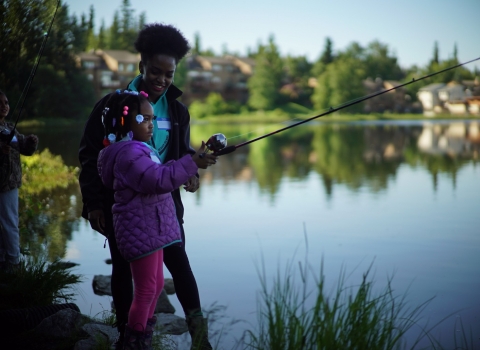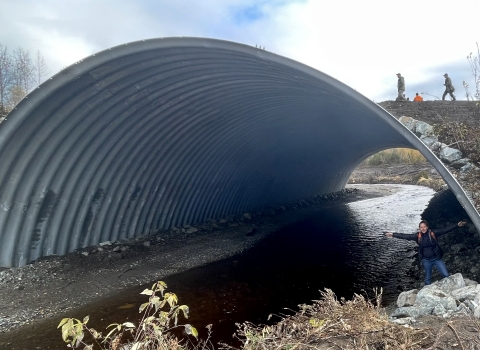Looking for the best way to catch a catfish, land a lake trout, or snag a smallmouth? Whether you are a beginning angler wondering about walleye or teaching your kids to fish for crappie, here’s a roundup of some of our favorite fishing tips from the experts who raise them.
The National Fish Hatchery System raises and stocks over 98 million fish every year to support recreational fishing, tribal subsistence fisheries, and the recovery and restoration of imperiled species. Whenever you grab your rod and hit the water, you are supporting conservation. Fishing license sales and special taxes on fishing gear and motorboat fuels generate billions of dollars in funding to support state conservation efforts.
Buying a fishing license is quick, easy and directly contributes toward conservation efforts. In most states, licenses can be purchased online, by phone or at retail establishments.
Note: Distribution numbers are based on 2020 reporting.
Walleye (Sander vitreus)
How many walleye we provide: 26,500,000
Hatcheries that raise walleye: Garrison Dam National Fish Hatchery, Gavins Point National Fish Hatchery, Genoa National Fish Hatchery, Private John Allen National Fish Hatchery, Valley City National Fish Hatchery
Other names: walleyed pike
The basics: They say once you eat walleye, you'll be hooked. And speaking of hooked, when you get a walleye on your line, be prepared for a deep and stubborn fight to land it. Once you land this fighter, give yourself a pat on the back. Walleye tend to be line shy so they are harder to catch.
Everyone has their preferred fishing methods and bait choices for catching walleye. You can try drift, still fishing or trolling, and minnows are a favorite bait of many.
Insider fishing tip: “Want to catch more walleye? Fish for walleye on days where the winds create short choppy waves, also known as the walleye chop. This chop on the water often causes these predators to become very active and to bite aggressively.” By Tim Smigielski, Great Lakes Regional Office
Learn more about fishing for walleye!
Lake trout (Salvelinus namaycush)
How many lake trout we provide: 4,200,000
Hatcheries that raise lake trout: Sullivan Creek National Fish Hatchery, Pendills Creek National Fish Hatchery, Jordan River National Fish Hatchery, Iron River National Fish Hatchery, Dwight D Eisenhower National Fish Hatchery, Dale Hollow National Fish Hatchery, Allegheny National Fish Hatchery
Other names: mackinaw, siscowet
The basics: Lake trout don’t hang out in schools, but they do stay in the same areas. So wherever you catch one, there is a chance you could catch many.
These fish prefer to live in cold, deep lakes and the best time to catch lake trout depends on several factors like the time of day, temperature, and even the time of year. They avoid bright lights, so try fishing when it is overcast. Fishing during their feeding, around dawn and dusk, provides another opportunity to catch these fish.
Insider fishing tip: “Lake trout are most often found in the deep cold waters of large lakes in the upper latitudes of North America. An aggressive feeder, these trout can be captured by trolling, vertical jigging or casting artificial baits over reefs and rocky points.” By Roger Gordon, Jordan River National Fish Hatchery, Michigan.
Learn more about fishing for lake trout!
Brook trout (Salvelinus fontinalis)
How many brook trout we provide: 450,000
Hatcheries that raise brook trout: Alchesay/Williams Creek National Fish Hatchery , Berkshire National Fish Hatchery, Chattahoochee Forest National Fish Hatchery, Dale Hollow National Fish Hatchery, Dwight D Eisenhower National Fish Hatchery, Erwin National Fish Hatchery, Genoa National Fish Hatchery, Greers Ferry National Fish Hatchery, Iron River National Fish Hatchery, Jordan River National Fish Hatchery, Nashua National Fish Hatchery, North Attleboro National Fish Hatchery, Wolf Creek National Fish Hatchery
Other names: speckled trout, brook charr or char, coaster trout refers to sea-run (anadromous) or lake-run (potadromous) populations, brookies
The basics: So many ways to fish for brook trout, let us count the ways. We can come up with at least four!
From fly fishing to spin casting, to bait casting and still fishing, fishing enthusiasts love to catch brookies. In fact, these fish are one of the most popular game fish in North America.
Brook trout can be found in a variety of water bodies that provide three important factors: cool and clean water, food, and cover from natural predators.
Insider fishing tip: “When fishing for brook trout, approach the stream to cast your line, carefully and quietly. In clear water, avoid casting your shadow on the water, to avoid scaring away any fish that see you or movement.” By James Gray, Wolf Creek National Fish Hatchery, Kentucky
Learn more about fishing for brook trout!
Black crappie (Pomoxis nigromaculatus)
How many black crappie we provide: 230,000
Hatcheries that raise black crappie: Genoa National Fish Hatchery, Gavins Point National Fish Hatchery
Other names: none
The basics: Crappie fishing varies by angler with each having their own opinion on the best way to catch them. The tackle and technique you use will depend on the time of year and where you are fishing. There are two species of crappie, black and white, but both are the same color. You can tell them apart by their spotting pattern and number of dorsal fins.
Insider fishing tip: “ Bring a little extra tackle when targeting crappie because the best fishing is often found in snag-happy flooded timber. I like to cast a tiny spinnerbait (like a Beetle Spin) or fish a minnow below a slip bobber around submerged trees when fishing in reservoirs.” By Sam Stukel, Gavins Point National Fish Hatchery, South Dakota
Learn more about fishing for crappie!
Channel catfish (Ictalurus punctatus)
How many channel catfish we raise: 1,600,000
Hatcheries that raise channel catfish: Edenton National Fish Hatchery, Inks Dam National Fish Hatchery, Natchitoches National Fish Hatchery, Orangeburg National Fish Hatchery, Private John Allen National Fish Hatchery, Tishomingo National Fish Hatchery, Welaka National Fish Hatchery
Other names: none
The basics: Whether a beginner or advanced angler, young or old, these fish are one of the most popular to set your hook on. Channel catfish, one of several species of catfish, are not too hard to catch, when you find them. You can fish from the bank or from a boat, day or night, and be successful either way. And after a day of fishing, they taste great on the dinner table.
Insider fishing tip: “Every fisherperson seems to have their own secret recipe for catching catfish. Cut shad seems to be the most popular for the fishing population around here.” By Kerry Graves, Tishomingo National Fish Hatchery, Oklahoma
Learn more about fishing for catfish!
Smallmouth bass (Micropterus dolomieu)
How many smallmouth bass we raise: 53,000
Hatcheries that raise smallmouth bass: Warm Springs National Fish Hatchery, Genoa National Fish Hatchery
Other names: smallies
The basics: Smallmouth bass are also known as smallies among anglers. Landing one though, no small feat. In fact, they are said to be one of the hardest fighting fish in North America.
Successfully catching smallmouth depends on water temperatures and the time of year. They like it best when the temperature is between65 and 75 degrees. Your best bet is to try different locations and water depths. Just because you had luck in one area, don’t stay glued to that spot. Most likely you’ll need to adjust your fishing location and water depth daily, depending on fishing conditions.
If you find baitfish or crayfish, most likely smallmouth bass are nearby.
These fish live in lakes, rivers, and cool flowing streams and reservoirs fed by these streams.
Insider fishing tip: “When fishing for smallmouth bass in north Georgia waters use fathead minnow live bait in the winter. In the summer, use spinner baits and crankbaits on ledges in deeper water.” By Josh Simmons, Warm Springs National Fish Hatchery, Georgia
Learn more about fishing for smallmouth bass!
Responsible Fishing Supports Conservation
Each one of us has an important role to play in ensuring that future generations have the same opportunities to enjoy nature that we do. One of the best ways you can protect wildlife and habitat when fishing and boating is to prevent the spread of invasive plants and animals. Whenever you leave the water, follow Clean. Drain. Dry. Dispose!
- CLEAN off visible aquatic plants, animals, and mud from all equipment before leaving water access — including hulls, interiors, and motors.
- DRAIN motors, bilge, live wells, and other water containing devices before leaving water access.
- DRY everything for five days OR wipe with a towel.
- DISPOSE of unwanted bait, fish parts, and packing materials, in the trash; never dump live fish or other organisms from one water body into another.
Purchase a fishing license!
Buying a fishing license is quick, easy and directly contributes toward conservation efforts. In most states, licenses can be purchased online, by phone, or at retail establishments.













